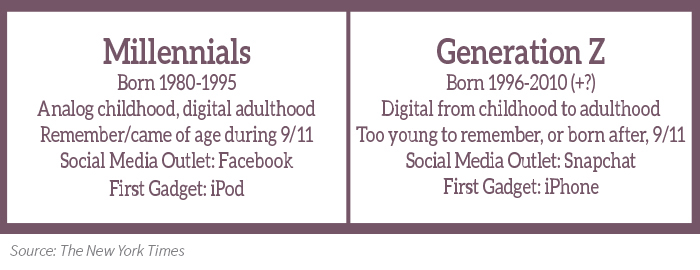Everyone’s been talking about younger consumers for quite some time. Millennials have been maligned for years, and as Gen Z begins its journey into adulthood and increased purchasing power, much effort has been made to understand them. What do they like? What don’t they like? How are they different and the same from the generations before them?
These are important questions, and we’re certainly not the first to ask them. But it’s essential to take stock of the latest information, since both Generation Z and millennials will continue to have a large impact on our social and economic futures. So often they are lumped together, when really these two groups have some serious differences. More importantly (from our perspective), they interact with media in some very unique ways. This issue is all about breaking down these nuances for you.
ARTICLES IN THIS ISSUE
- In-Home Smart Device Usage for a Younger Generation
- Are Younger Consumers in Love with Ad Blockers? It’s Complicated
- Beyond Cable and OTT: The Video Habits of Millennials and Gen Z
- Digital Natives vs. Social Natives
- Tuning in to Podcasts: New Opportunities for Meaningful Messaging
- Meeting in the Middle: Adapting Sports Broadcasting for the Digital Age
Read More
Everyone’s been talking about younger consumers for quite some time. Millennials have been maligned for years, and as Gen Z begins its journey into adulthood and increased purchasing power, much effort has been made to understand them. What do they like? What don’t they like? How are they different and the same from the generations before them?
These are important questions, and we’re certainly not the first to ask them. But it’s essential to take stock of the latest information, since both Generation Z and millennials will continue to have a large impact on our social and economic futures. So often they are lumped together, when really these two groups have some serious differences. More importantly (from our perspective), they interact with media in some very unique ways. This issue is all about breaking down these nuances for you.
ARTICLES IN THIS ISSUE
- In-Home Smart Device Usage for a Younger Generation
- Are Younger Consumers in Love with Ad Blockers? It’s Complicated
- Beyond Cable and OTT: The Video Habits of Millennials and Gen Z
- Digital Natives vs. Social Natives
- Tuning in to Podcasts: New Opportunities for Meaningful Messaging
- Meeting in the Middle: Adapting Sports Broadcasting for the Digital Age
LET’S GET THIS STRAIGHT: IDENTIFYING MILLENNIALS VERSUS GEN Z
We’re all familiar with the stereotypes: Millennials are killing paper napkins/doorbells/beer/Applebee’s because they are still living with their parents and keep ordering avocado toast, while Gen Z can’t get off their phones and won’t stop doing YouTube dares. While there is occasionally a grain of truth to these generalizations, like all generations these groups are incredibly complex. According to Nielsen’s Q1 2017 Total Audience Report, Gen Z and millennials together make up 48 percent of the population. These generations have significant implications for brands and their marketing strategies, so it’s increasingly important that brand marketers understand the similarities and differences between them.
Throughout the years, the cutoff range for these two groups has wavered. Some marketers argued over how to properly classify those who fell into various age overlaps, while others just avoided defining the divide entirely. However, as more of the Gen Z group comes of age, a clearer picture of what truly separates, and unites, these two demographics is becoming increasingly apparent. Our aim in this issue is to dive deep into those behavioral and attitudinal nuances, through the lens of today’s important media and marketing topics.
For the purposes of this issue, we’ve referenced the following guidelines for defining these generations:

The goal of defining these generations, through both age and major occurrences throughout their formative years, is to create a sound framework for analysis. It’s also important to acknowledge that various subgroups and important subtleties exist within these bounds. However, these generation definitions provide a foundation for a conversation around their interactions with media and marketing. We hope the observations around these interactions help your team make sense of the exciting marketing opportunities that surround these generations both today and tomorrow.